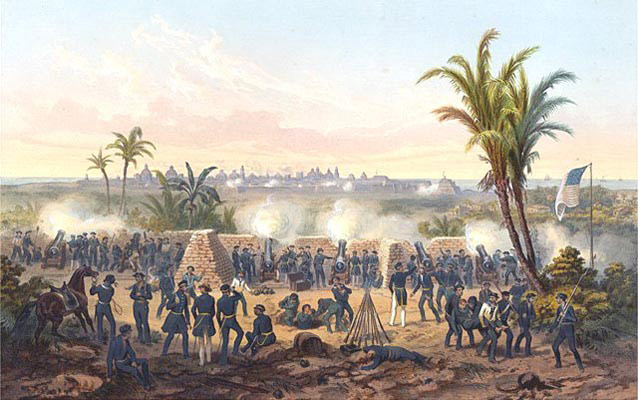Last updated: May 21, 2015
Lesson Plan
Battling Disease

- Grade Level:
- Middle School: Sixth Grade through Eighth Grade
- Subject:
- Social Studies
- Lesson Duration:
- 30 Minutes
- Common Core Standards:
- 6-8.RH.10
- State Standards:
- State: Texas
Subject: History
Grade Level: 8th
State Standards: 8.6 - Thinking Skills:
- Understanding: Understand the main idea of material heard, viewed, or read. Interpret or summarize the ideas in own words. Applying: Apply an abstract idea in a concrete situation to solve a problem or relate it to a prior experience. Analyzing: Break down a concept or idea into parts and show the relationships among the parts. Creating: Bring together parts (elements, compounds) of knowledge to form a whole and build relationships for NEW situations.
Objective
In this lesson, students will answer the following essential questions: How has the prevention and battling of health threats changed between the US-Mexican War and today?
Background
The 2-minute video segment "Medicine in the War" can be used to accompany this lesson plan. The video clip can be downloaded from our For Kids page. Students can work individually or in groups. Each individual or group can review one or all four health threats.
Preparation
-
Print one copy per student of each material listed.
-
Find the 2-minute video segment "Medicine in the War" which can be used to accompany this lesson plan. The video clip can be downloaded from our For Kids page.
Materials
Use this worksheet to divide your students in step one.
Download Battlefield Stats: Deaths from Battle Wounds vs. Deaths from Disease
Students read this to gain background knowledge.
Download Battling Disease Student Background
Student use this worksheet to compare and contrast US-Mexican War and modern medical technology.
Download Battling Disease Venn Diagram
Lesson Hook/Preview
-
Use Battlefield Statistics: Deaths from Battle Wounds vs. Deaths from Disease to divide students into two different parts of the room.
- Tell students that they are all soldiers who died during the U.S.-Mexican War. The bigger group died of disease and the smaller group died in battle or because of battle wounds.
Procedure
-
If possible, watch the 2-minute video "Medicine in the War" which can be downloaded from our For Kids page.
-
Hand out the Battling Disease Student Background worksheet. Have students read to themselves or out loud.
-
List each of the four health threats on the board. Health threats include: poor drinking water, poor camp conditions, mosquitoes, poor personal hygiene.
-
Ask students what can happen to their health if: they drink dirty water, there is too much garbage lying around, there are a lot of mosquitoes, they do not take baths and care for their body. List responses on the board.
-
Tell students that Dr. Madison Mills was the Assistant Surgeon of the U.S. Army during the Battle of Palo Alto. His advice was to implement the modern medical technology available in 1846. Today we still do some of these things to stay healthy, but we also have modern medical technology like vaccinations.
-
Split students into four groups, one for each health threat. (Option: Have students work in smaller groups or work individually and assign the same health threat to several groups/individuals.)
-
Hand out the Battling Disease Venn Diagram to groups/individuals to compare and contrast medical technology during the War with modern medical technology. (Option: Give an example such as: Threat: Poor hygiene; Technology: Take a bath)
-
Tell students when they are finished with the Venn diagram to answer the questions on the back of the worksheet.
- Have students present their diagrams and answers to the class.
Vocabulary
-
Wound – injury that is usually more serious
-
Disease – illness or sickness
-
Surgeon – Doctor in the military who usually focuses on surgery
- Hygiene - Cleanliness
Assessment Materials
Student AssessmentAssess student performance in two key areas
1. Participation in group discussion
2. Worksheets
Rubric/Answer Key
Above Proficient
Group discussion: Offers information, which directly relates and builds on the topic.
Worksheets: Venn Diagram complete. Thoughtful answers. Effective and accurate use of writing conventions. Drawings complete.
Proficient
Group discussion: Offers information, which directly relates to the topic.
Worksheets: Venn Diagram complete. Effective and accurate use of writing conventions. Drawings complete.
Below Proficient
Group discussion: Offers very little information of which some relates to the topic.
Worksheets: Venn Diagram incomplete. Writing conventions are not always followed. Drawings incomplete or no drawings.
Supports for Struggling Learners
-
Read text out loud prior to answering questions
-
Mixed-ability partnerships
- Highlighted text
Enrichment Activities
- Have a class discussion about the modern health tips that the students came up with to avoid disease.
-
Have students pretend to be Dr. Madison Mills and write a short essay about what the soldiers should do to stay healthy.
- Have students set a personal health goal and track progress towards its achievement.
Additional Resources
The video to accompany this lesson plan can be downloaded from our For Kids page. Click on "Medicine in the War."
Information on U.S. Army Medical History is in U.S. Army Medical Department,1818-1865 by Mary C. Gillett
